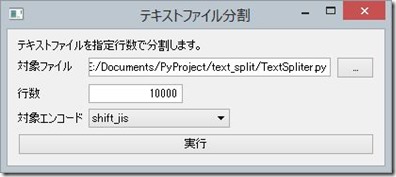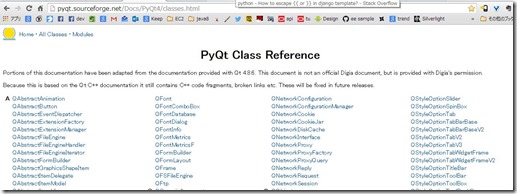PyQt を使って GUIテキストファイル分割ツールをPythonで作成する
PyQtを使うと、Pythonで作成したコマンドラインのユーティリティプログラムに、ひと手間加えるだけで、GUIのインターフェースを作成できて非常に便利。
こんな程度なら、ちょいちょいっと、リファレンスを調べながら、ノリで作成できる手軽さもよい。
http://pyqt.sourceforge.net/Docs/PyQt4/classes.html
リファレンスページも、見やすい(検索しやすい)ので、だいたい、それっぽいキーワードで検索するとそれっぽいクラスが引っ掛かる。
self.txtLimit.setAlignment(core.Qt.AlignRight)
上記(テキストのアライメントを右寄せ指定)のように、メソッドのパラメータに渡す列挙型などは、QtCoreモジュールのQt クラスに定義されている。
モジュール一覧
http://pyqt.sourceforge.net/Docs/PyQt4/modules.html
Qtクラス
http://pyqt.sourceforge.net/Docs/PyQt4/qt.html
コード
# -*- encoding:utf-8 -*-
import sys
import re
import os
from datetime import datetime
from PyQt4 import QtGui as gui
from PyQt4 import QtCore as core
import re
import codecs
class MainWindow(gui.QWidget):
def __init__(self):
super(MainWindow, self).__init__()
self.initUi()
def initUi(self):
grid = gui.QGridLayout()
form = gui.QFormLayout()
self.txtSepFile = gui.QLineEdit()
btnSepFile = gui.QPushButton(u'...')
btnSepFile.setMaximumWidth(40)
btnSepFile.clicked.connect(self.chooseDbFile)
boxSepFile = gui.QHBoxLayout()
boxSepFile.addWidget(self.txtSepFile)
boxSepFile.addWidget(btnSepFile)
form.addRow(u'対象ファイル', boxSepFile)
self.txtLimit = gui.QLineEdit()
self.txtLimit.setText(u'10000')
self.txtLimit.setAlignment(core.Qt.AlignRight)
self.txtLimit.setFixedWidth(100)
form.addRow(u'行数', self.txtLimit)
encodes = ('shift_jis','cp932','utf-8')
self.cmbSrcEncode = gui.QComboBox(self)
self.cmbSrcEncode.addItems(encodes)
self.cmbSrcEncode.setFixedWidth(150)
boxSrcEncode = gui.QHBoxLayout()
boxSrcEncode.addWidget(self.cmbSrcEncode)
form.addRow(u'対象エンコード', boxSrcEncode)
boxCtrl = gui.QHBoxLayout()
btnExec = gui.QPushButton(u'実行')
btnExec.clicked.connect(self.doExec)
boxCtrl.addWidget(btnExec)
msgCtrl = gui.QVBoxLayout()
msgCtrl.addWidget(gui.QLabel(u"テキストファイルを指定行数で分割します。"))
grid.addLayout(msgCtrl,0,0)
grid.addLayout(form,1,0)
grid.addLayout(boxCtrl,2,0)
self.setLayout(grid)
self.resize(400,100)
self.setWindowTitle(u"テキストファイル分割")
self.show()
def doExec(self):
in_file = unicode(self.txtSepFile.text())
in_codec = unicode(self.cmbSrcEncode.currentText())
s_limit = unicode(self.txtLimit.text())
if not unicode.isnumeric(s_limit):
gui.QMessageBox.warning(self,"Completed",u"行数の指定が不正です。")
return
self.separateFile(in_file, in_codec, int(s_limit))
gui.QMessageBox.information(self,"Completed",u"作成完了しました。",gui.QMessageBox.Ok)
def chooseDbFile(self):
dialog = gui.QFileDialog()
dialog.setFileMode(gui.QFileDialog.ExistingFile)
if dialog.exec_():
fileNames = dialog.selectedFiles()
for f in fileNames:
self.txtSepFile.setText(f)
return
return self.txtSepFile.setText('')
def separateFile(self, in_file, in_codec, limit):
extention = ""
out_file = in_file
try:
in_sep_period = in_file.split(".")
extention = in_sep_period[1]
out_file = ".".join(in_sep_period[:-1])
except IndexError:
pass
in_fd = None
out_fd = None
try:
sufix = 0
line = 0
in_fd = codecs.open(in_file, 'r', in_codec)
for l in in_fd:
if line == 0:
if out_fd:
out_fd.close()
sufix = sufix + 1
outf = out_file + '_%05d.%s' % (sufix, extention)
out_fd = codecs.open(outf, 'w', in_codec)
print "%s..." % (outf)
out_fd.write(l)
# print l
line = line + 1
if line >= limit:
line = 0
except UnicodeDecodeError:
gui.QMessageBox.warning(self,"Completed",u"エンコードエラー。エンコードの指定を確認してください。")
if out_fd:
out_fd.close()
if in_fd:
in_fd.close()
pass
def main():
app = gui.QApplication(sys.argv)
mainWin = MainWindow()
sys.exit(app.exec_())
if __name__ == '__main__':
main()


